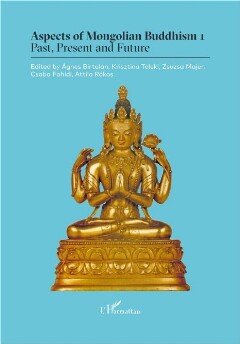Seite 452 [452]
KUNDSE CHIMED
Tibet, Kubilai Khan and Queen Cinbai, their sons and other royal families became his
main benefactors. Also we can read about it in Phagpa Lama’s letters to Queen Cinbai.
Queen Taixal (15—16" Century)
The youngest son of Dayan Khan (Khal. Dayan xän), a descendant of the Golden
Lineage (Altan urag) of Chinggis Khan (Khal. Cingis xän), was married to Cin Bisrelt
Mat’ Taixal, the daughter of Berx from Ongüd aimag. In a historical source, she is
mentioned as Cin Bisrelt Taixal or Cin Taixal or Queen Taixal. Cogt Taij and Queen
Taixal were worshipers of the Nyingmapa Tradition of Tibetan Buddhism. They built
six temples between 1601 and 1617 on the west side of River Tuul (Khal. Tal) and
also in front of Mountain Khalduun Zürkh (Khal. Xaldün Jürx). Also they wrote the
following about the reason for building the literacy house or “White House” saying
“By the virtue of the mother and the son, may the king, his assistants live long free
from diseases and may the state be in peace, the time be prosperous and all the bad
phenomena be pacified! May Cin Taixal and Cogt Taij, daughters and sons, their subject
officials be prosperous and victorious!” This was a wish about the peace of the state
and to be free from chaos and wars.
They built a temple (in the area of the present DaSin¢ilen sum in Bulgan aimag) that
served as a center of culture and education where the Noble Dharma was preached and
translated, many thousands of poems were written, and Dharma texts were copied and
printed. Also it was a place for boys and girls to get educated. It is said that many of
these works were accomplished under the guidance of Lama Karma Tenzin Phuntsok
of the Kagyu Tradition. Particularly, under the patron of Queen Cin Taixal, a large
number of sütras/manuscripts were translated from the Tibetan into the Mongolian
language. In fact, she was a genuine practitioner studying the Noble Dharma, and an
admirer of ancient religious texts. When Gis Coeje of Inner Mongolia translated the
autobiography of Milarepa into the Mongolian language, he mentioned their devotion
in the last stanzas of the autobiography;
Tsogt Khuntaij, the Glorious one,
Who flourished the unmistaken Dharma,
Has attained Wisdom
And learnt the profound meaning of the Dharma
By the bravery of the mother and the son,
Who gave an order of the translation
Of this precious autobiography,
As well as with a motivation for the sake of all beings,
I, Pandita shireet Choije, composed/translated it in a poetic way
By deep studies of this profound Dharma
450

